|
by David B. Richman, USA |
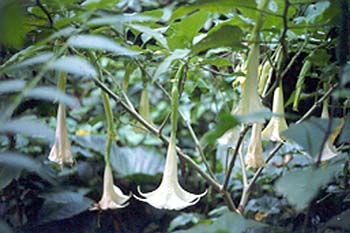
Brugmansia. Trinidadian rain forest (Northern range). |
|
by David B. Richman, USA |

Brugmansia. Trinidadian rain forest (Northern range). |
I fell in love with tropical rain forests when I was a kid growing up in the desert. Of course, I didn’t call them rain forests then. They were jungles and I first encountered them in the writings of William Beebe, the fiction of Edgar Rice Burroughs, and various comic books. I envisioned a reeking, dangerous animal-filled tropical forest filled with epiphyte covered trees. (I have to admit that I learned the very word “epiphyte” from a Tarzan comic.) How I wished to be in the jungle. When I read the Jungle Book by Kipling I fantasized about being Mowgli and living absolutely free in the jungle. I didn’t know then that Mowgli’s “jungle” was not even a rain forest, but the dryer forest of India. My dreams were divided between the jungle and the ocean (filled with manta rays, man-eating sharks, giant octopi and squid.) They both seemed like paradises to my hungry imagination. Perhaps, I thought, some day I might visit such fascinating places. However, I never believed that I had much hope of it. Growing up, as I was, in a river valley in the hyperarid desert around Yuma, Arizona, with the nearest rain forest in southern Mexico, hundreds of miles to the southeast, it seemed an impossible and impractical dream. Oceans were a little closer, but still not easily reached. To me they might just as well have been on the moon. I could not even imagine that I would ever leave Yuma, much less visit a rain forest or an ocean. Still, rain forests gained from being terrestrial and as I could not swim at the time, they seemed more attainable, despite the distance.

Trinidadian rain forest (Northern range).Unlike many people who dream about tropical forests I was mostly fascinated with the much less known smaller denizens—ants, beetles, spiders, fungi and microorganisms—that lived on the plants and in the leaf litter. I read with deep interest William Beebe’s description of a square foot of jungle leaf litter and soil. I later agreed with E. O. Wilson’s statement that given a second life he would like to become a microbial ecologist specializing in the tropical forests.
However, as I became older my new dreams were more practical: going to college and getting a Ph.D. in zoology. This just might allow me to go back to the old dream of studying living things in remote areas of the planet, including rain forests. Even the hope of college seemed impossible, as my family was far from wealthy. It was thus a total surprise to me that, through a series of chance happenings and help from many people, I found myself one day a few years out of graduate school on the mountain called El Yunque in Puerto Rico in the midst of a undeniable rain forest. I was searching for spiders primarily, as I had become an arachnologist, although I was making my living as an entomologist. The forest was complete with tree ferns and graceful palma de la sierra, almost archtypical symbols of rain forest. The tall ferns, remainders from an age where large reptiles were dominant, rose over my head and the palms gleamed with their whitish trunks and long green fronds. Even if the Caribbean fauna and flora was not as spectacular as that of Central or South America, it still was a paradise to me. I would later visit another, more diverse, rain forest in the Caribbean, but the Puerto Rican forest was my first introduction to these biologically rich paradises.
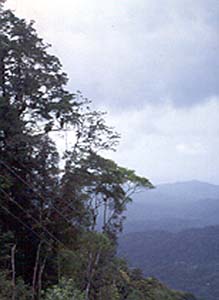
Trinidadian rain forest
(Northern range).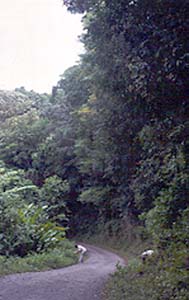
Trinidadian rain forest
(Northern range).My long-dreamed-of visit to a real, if diminished, rain forest came about at the end of a very practical trip. Our little research group from the University of Florida was in Puerto Rico studying the effects of native predators of the notorious sugar cane rootstalk borer weevil, Diaprepes abbreviatus. The weevil has one of the broadest host ranges known, attacking citrus, sugar cane, mangoes, papayas, various ornamental plants, chili peppers, and even oak trees. The chance introduction of this horror to Florida had brought us to Puerto Rico to study the native enemies of the weevil in its homeland.
On our return from the citrus and coffee groves of Isabella, Adjuntas and Mayaguez, we decided to take a side trip to visit the rain forest of El Yunque. The Puerto Rican rain forest is a shadow of what it once was. Only the Sierra Luquillo is relatively pristine, most of the rest of Puerto Rico having been logged, turned into villages and agricultural areas or back to second growth. Despite this the plant diversity remaining is astonishing. On an island extending less than half the width of New Mexico and only 30 miles wide, there are 500 species of native trees and at least 250 more introduced species! There is a whole book on the ferns of the Sierra Luquillo. Yet the island is often thought of as a has been, much less interesting than Costa Rica, Belize, and other areas of Central and South America. Still, in two trips to Puerto Rico that totaled three weeks I discovered two undescribed species of jumping spider and found a new record for a third. All these were collected in disturbed lowland areas before we even visited the relatively untouched rain forest. The two undescribed species (which are unfortunately still undescribed) were actually found in the southern dry Caribbean scrub near Caña Gorda (“Big Cane”). Not too bad for an island thought by many to have been thoroughly worked over. Now the Diaprepes project gave me the totally unexpected opportunity to visit at least one rain forest area, if only for a few hours.
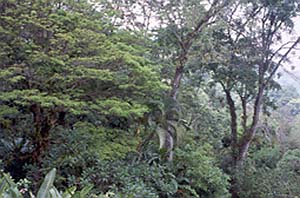
Trinidadian rain forest (Northern range).We drove up the winding highway in our rented Ford Escort, stopping along the way to look at tropical foliage and the local arthropod fauna. At one spot it rained twice while we stopped, thus proving that the title “rain forest” was appropriate. We saw a large spider, probably a sparassid or giant crab spider, in a mass of vegetation, but it scuttled into the litter before I could be sure what it was. We also noted a number of colorful land snails climbing on the wet plants and several spiders in the low growing vegetation. Already the rich, dank, almost delicious, smell of the forest filled us with an exhilarating enthusiasm. It was almost as if someone was baking a rich pan of gingerbread. Everything in the forest dripped from the rain and mist, but the dampness did not seem oppressive to me. I was in heaven! The hand-like leaves of cecropia trees, the strange flowers of Heliconia plants (relatives of the banana), the tree ferns and palms, plus countless other plants unknown to me, all gave me an eerie, but pleasant, feeling. A sense of a unique spirit of place. The leaf litter was a treasure house of tiny spiders and ants, including very spindly-legged Modisimus pholcid spiders.
We piled back into the Escort and drove as far up as the road would take us on the slope of El Yunque. The mist lifted for a short time and sunlight poured through the trunks of the tall tree ferns. I found a brilliant black and metallic blue jumping spider on the leaf litter—an immature male Anisaitis. I had found similar, but differently colored, jumping spiders in the coffee and banana plantation next to our hotel on the campus of the University of Puerto Rico. I took several photographs of the rain forest, but only a few turned out well. Anne Trambarulo, one of the members of our group of entomologists, explained that the gods of El Yunque always cause the photographs to turn out badly. I had my doubts about this explanation, but it was a good story. El Yunque looked like a place for malevolent, or at least indifferent, gods, being largely covered with mist from rain clouds.
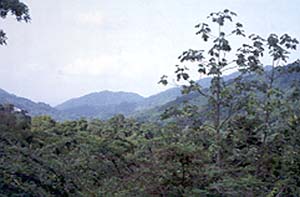
Trinidadian rain forest (Northern range).We stopped on our way down the mountain to view a video on the endangered Puerto Rican parrot at the Caribbean National Forest visitor center. Ironically, this was our only view of these indigenous Amazons. The native parrots, with their beautiful green plumage with the red markings, may eventually disappear from the earth. A hurricane apparently killed several of the birds several years after our visit and they became even more rare. It is a pity, as only introduced parrots will be left once these great amazons are gone. The invaders will never take their place, however beautiful they may look, and they often cause more problems than they are worth.
Finally, we stopped once more near a trailhead and Anne and I walked down the rain forest trail to the sound of rushing water everywhere. The sound of cascading water under the now cloudy and threatening skies was never absent. I was in heaven, but I knew it was an ephemeral heaven. As we walked back to the car and the waiting rest of the party, I briefly wished that I could simply stay in “my” rain forest paradise. But the practical side of me regained control. With resignation I joined the others on the trip back to San Juan to catch our flight back to Gainesville, via Miami.
Quite a few years later (1999) I was again able to visit the tropics, this time both the tropical island of Trinidad and later the Mexican State of Chiapas. I visited Trinidad to attend the yearly meeting of the American Arachnological Society and Chiapas to assess a project on cotton IPM in which a colleague and I were involved.

Bromeliad. San Augustine campus
of the University of the Caribbean.
Trinidad.I spent a considerable amount of time collecting spiders and other arthropods (under permit) around the island of Trinidad. The specimens were donated to the Florida State Collection of Arthropods in Gainesville for a project to document the jumping spiders (Salticidae) and other spiders of Trinidad and Tobago. The strange spiders were quite interesting, but I was also especially happy to see two organisms I had often read about in William Beebe’s books—leaf-cutting ants (Atta sp.) and army ants (Eciton sp.). The former was found in abundance in the Arena Forest (lowland Caribbean tropical forest) and the latter at Asa Wright Nature Center (true rain forest in the Northern Range). We were returning from our tour of the forest and observing wildlife from mot-mots and bellbirds to manikins when we found a stream of army ants in the middle of the trail. What an end to a fantastic day! I was already enthralled with the tropics. However, the day was not completely over as I topped off the visit to Asa Wright with a telescopic view of a toucan feeding in the trees and the distant roof of William Beebe’s old research station at Simla!
I am well aware that William Beebe’s adventures were often exaggerated and that his contributions to science were somewhat less than he would have his readers believe. At the same time he was a good writer and his often-purple prose introduced me to the romance of the tropics. Beside, his assistant Jocelyn Crane published fascinating descriptions of the jumping spiders of Rancho Grande, Venezuela, including discussions on their behavior. These were major references for me while I wrote my dissertation while I was at the University of Florida.
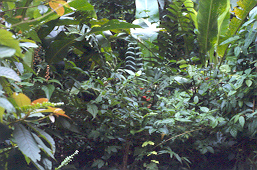
Trinidadian rain forest (Northern range).Even the lowland tropical forest of Arena was of interest. The earlier mentioned leaf-cutting ants were abundant and their columns of apparently animated leaf fragments wound over the litter at our feet. Tropical birds like silver-beaked tanagers, bananaquits, and parrots flew over and through the lush bush as we got occasionally drenched with sudden rains. This was usually followed in a short time by bright sunshine. We were warned that we should be careful about where we walked, as this was a time when the fer-de-lance snakes (fairly deadly pit vipers) were commonly about. I collected strange jumping spiders near a sandpit and was attacked by the elegant Sabathes mosquitoes along a forest trail. These mosquitoes have feather-like structures on their hind legs that make them somewhat resemble some sort of dancer. Their bites are to be avoided, however, as they can transmit some tropical diseases. In the tropics all mosquitoes are suspect except for the huge Toxyrhynchites (oddly seen as the “dinosaur blood-filled” mosquito in amber in the original “Jurassic Park”), which do not feed on blood at all, but on nectar! Interestingly the “amber” mosquito was also a male, which feed only on nectar in all known species of mosquito!
Chiapas was a different situation. I could not obtain permits to collect spiders and so was content to visit the ruins of a pre-Mayan city and a crocodile farm. I did get a chance to visit the well-equipped biodiversity center in Tapachula to help them with salticid identifications. This gave me a chance to view some of the local jumping spiders through their excellent binocular microscopes. Several were cosmotropical species, such as Menemerus bivittatus and Plexippus paykulli. These are basically tramp species, as are many of the ants and some of the spiders in Puerto Rico. Tramp species are those that travel around the planet along with humans and take hold wherever the environment is favorable to them. I have collected Plexippus paykulli in Florida and in Las Cruces, New Mexico. I have seen specimens of Menemerus bivittatus (also common in Florida) from a steamer on the Paraguay River where one of my friends collected them in the early 1970s and have seen them myself on rest room walls in Los Mochis, Sinaloa, Mexico, during the same period.
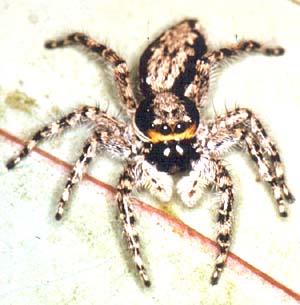
"Tramp" salticid spider. Menemerus bivittatus (female)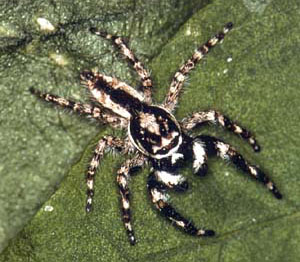
"Tramp" salticid spider. Menemerus bivittatus (male)I never got into the true rain forest of Chiapas at El Triunfo, partly because of time and partly because of the off and on civil war in the highlands. This was a serious lack, because the lowland forest is mostly second growth and agricultural land, but still it was the tropics. The ancient pre-Mayan city of Izapa was showing signs of the reinvasion of the lowland tropical forest when I was there, and the acidity of the rain was also wiping the magnificent old steles (carved stone monuments) slowly blank. This was evident when they were compared with old photographs. Still, butterflies flitted around the old pyramids and I ached to sample the spider fauna. It was a grand place!
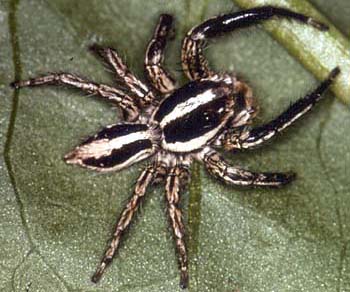
"Tramp" salticid spider. Plexippus paykulli (male)I can claim no special experience with the tropical forests as I have spent only a very short time within their confines. In some ways my writing about these meager interludes is as arrogant as William Beebe’s writing a whole (and very large) book on his first very short visit to the Galapagos, however I hope my readers will forgive this transgression. I just want to convey an impression of one biologist who was, because of circumstances, lucky to even be in such places at all. I will always remember Puerto Rico, Trinidad and Chiapas—the friendly people, the great food, the tropical (and often introduced) flowers and fruit, but most of all I will especially remember the rain forests of Puerto Rico and Trinidad. These are somewhat depauperate rain forests compared with those of Venezuela, Brazil, Peru and Colombia, but they are rain forests none the less. I wished that I had more time in them to examine the tiny creatures that form the basis of the ecological systems. Each “jungle” pool was inviting, but I had no microscope with me with which to probe its secrets. However, just being there was food for the soul. The wet forests were quite different from the Gran Desierto in Arizona where I grew up, but in a way they were curiously similar. For there, just as in the bleak southwestern Arizona desert, true solitude was possible.
All comments to the author David Richman are welcomed.
Image credits and acknowledgements
The spider images were kindly supplied by G. B. Edwards. All other images are by the author.
Thanks to my friend Susan Tweit and my wife Lynda Goin for their suggestions and editorial help.
Please report any Web problems or offer general comments to the Micscape Editor.
Micscape is the on-line monthly magazine
of the Microscopy UK web
site at Microscopy-UK